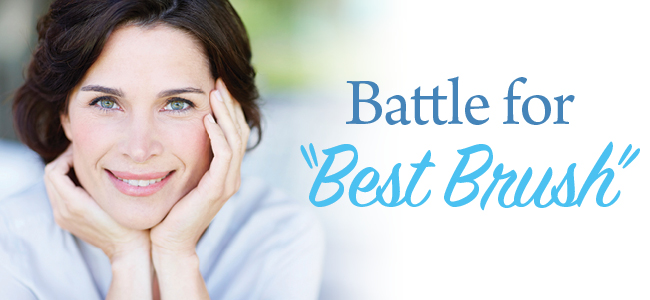By admin
08 Feb, 2016
Dental Health, Dental Tips, General Dentistry, Lifestyle
children's dentistry, dental health, gifts, healthy smile, pediatric dentistry, tooth-friendly treats, toothbrush, valentine's day

Nothing Is Sweeter Than a Healthy Smile
Valentine’s Day is a holiday that can leave many parents feeling conflicted. Anything that gives you an excuse to spoil your kiddos with gifts and tell them how much you love them is a welcome retreat from the daily grind of handing out chores and pushing through homework. One daily parenting task that commonly elicits dread is convincing your children to brush their teeth. Every parent knows how important their children’s oral health is, and instilling solid early oral hygiene practices so that your kids can enjoy a lifetime of healthy smiles is even more important. Thus the downside of Valentine’s Day: all the sugary treats.
Valentine’s Day is almost as notorious a threat to your kids’ teeth as Halloween. They inevitably come home from their classroom celebrations with paper bags full of chocolate and handfuls of candies with messages of love written on them. While these lovely confections please your kids, they are anxiety inducing when you catch yourself considering the damage being done to your children’s tiny pearly whites.
That’s not to mention the difficulty you face when trying to figure out gifts to give them and Valentines they can give to their friends and classmates that won’t cause cavities. While you can’t control what they will be bringing home, you can skip on contributing to acts of love that promote decay. Below we have put together four DIY, tooth-healthy Valentine’s Day gift ideas that show love while also producing happy, healthy smiles.
“You Make Me Smile” Toothbrush Valentine (Adapted from Time 2 Save Time 2 Give): This Valentine is simple to make and sends a sweet message while promoting good oral hygiene habits. You will need child-friendly toothbrushes, ribbon, colored paper, and a marker. Simply cut small hearts out of the paper and write a Valentine’s Day message like “You Make Me Smile” on each one. Attach ribbon to the back of the heart with tape and tie it to a toothbrush (still in package). You children’s classmates won’t be the only ones grinning! You can bet their parents will be feeling the love too.
Paper Airplane Valentine Free Printable (From NoBiggie.net): NoBiggie.net offers a free customizable, printable airplane Valentine that is perfect for the future pilots in your family. It’s quick and easy to make with corresponding numbers to help guide your way, and there’s even a video tutorial to walk you through creating the airplanes, making this a great last-minute go-to if you’ve been procrastinating.
I’m Nuts About You Treat Bag Printable (From Design Dining Diapers): If your children just have to hand out yummy treats, bags of peanuts are perfect. This tooth-friendly treat is low in sugar and high in protein, and if you go to the Design Dining Diapers site and follow the instructions, you can download a printable tag that says “I’m Nuts About You” and use it to fasten shut your baggie full of peanuts, leaving your children with a fun, yummy Valentine to hand out to friends.
Lunchtime Love: Show your children how much you love them with a little lunchtime love. You can give your children yummy hearts that aren’t made out of chocolate. Most kitchen-supply stores carry stainless-steel sandwich cutters in a variety of shapes and sizes. Use heart-shaped cutters to turn a turkey sandwich in a friendly reminder that you care. Smaller cutters can be used for meat and cheese slices or to turn slices of melon into a juicy, red dessert.
Valentine’s Day doesn’t have to lead to decay; there are plenty of candy-less ways to celebrate love. If your children come home with bags full of sugary goodies, make sure they brush their teeth after every treat — and then call us to book an appointment for a cleaning.
Happy Valentine’s Day from all of the staff at Douglas B. Weber, DDS!
More

Once every three or four months, you inevitably find yourself standing in the oral hygiene aisle at the grocery store scanning rows and rows of an endless variety of toothbrushes. They come in all shapes, sizes, and colors — and some of them even come with small motors. But how do you know which one is the best for you or your children?
The Basics
There are some basics you should look for when purchasing a new brush:
- The handle of the toothbrush should be a length and shape that best allows you to hold and maneuver it as you brush.
- The head of the toothbrush should be able to easily access all of the surfaces of your teeth. A half inch wide and one inch tall works best for most adults.
- Toothbrushes come with bristles that are categorized as hard, medium, and soft. Soft is preferable for most people; medium- and hard-bristled brushes can cause damage to tooth enamel.
- Choose a brush with American Dental Association-approved nylon bristles.
Manual or Electric
Electric toothbrushes have become increasingly popular over the last several years. They come in all shapes and sizes, and they are suited for both children and adults. But are they more effective than manually brushing your teeth with a traditional brush? The American Dental Association (ADA) has addressed this topic in multiple news releases, saying that manual brushes can indeed be as effective as electric. People using manual brushes who have excellent oral hygiene practices can prevent tooth decay as well as those who use electric.
Electric toothbrushes can be very helpful for people who have difficulty adequately brushing. Individuals who suffer from a disability or arthritis, as well as children just learning to brush, stand to benefit from using a suitable electric brush.
Manual vs. Electric
Both manual and electric toothbrushes have their benefits and their drawbacks. This is how they stack up next to each other.
Benefits of the Manual Toothbrush
- Teeth can be adequately cleaned after only two minutes of brushing.
- Toothbrushes come in a large variety of sizes, shapes, and colors, so you can find the one that works perfectly for you and each of your family members, including your children. Some children’s brushes come with their favorite characters on them, making them extra appealing and fun to brush with.
- Low maintenance and travel friendly, manual toothbrushes don’t require batteries or electricity for recharging, and you can just pop them in your travel pack or purse when you are on the go.
- Manual toothbrushes are low cost or free (with some dental visits).
Benefits of the Electric Toothbrush
- There’s little work with a lot of payoff. With very little effort, these toothbrushes thoroughly clean your teeth.
- Many electric toothbrushes come with a timer so you don’t even have to pay attention to the clock — perfect for those groggy mornings.
- hese brushes are child friendly and tend to alleviate the battle parents typically face when trying to get their children to brush their teeth. Oftentimes children even look forward to the task. These brushes also come with fun characters printed on them.
Disadvantages of the Manual Toothbrush
- Using a manual toothbrush requires more effort and attention than when using an electric toothbrush.
Disadvantages of the Electric Toothbrush
- These brushes are more expensive than the manual alternative.
- Electric brushes are higher maintenance as they require batteries and the ability to recharge, which also makes them more challenging to travel with.
There are some basics that should be covered by any good brush. Whether you should choose to purchase a manual toothbrush or an electric toothbrush for your oral hygiene routine largely depends on your personal and lifestyle choices. While choosing the right toothbrush for yourself and your children is important, dedication your daily at-home oral hygiene routine and making it to your routine dental visits is crucial to maintaining your oral health.
If you would like to learn more about products and oral hygiene habits that will help you maintain your best oral health, call us today at (661) 952-7865 to set up an appointment.
More
By admin
18 Jan, 2016
Dental Health, Dental Tips, General Dentistry, General Health
dental hygiene, gum disease, oral cancer, oral health, overall dental health, routine dental exam, toothpaste with fluoride

When you think about visiting the dentist, you most likely think about keeping your teeth white and straight, and having an attractive smile. What you may not realize is that maintaining good oral health has value beyond the obvious aesthetic rewards of a beautiful smile. Dedication to maintaining good at-home oral hygiene practices and making regular visits to the dentist protect your overall health and can help you avoid serious health complications and disease.
Healthy Mouth, Healthy Body
Recent research has linked gum disease to health problems that affect women and men of all ages. Gum disease is a bacterial infection, and as a result, it can enter the bloodstream and cause other health issues:
- Heart disease: Gum disease increases the risk of heart disease and doubles the risk of having a fatal heart attack. Heart disease is the number-one killer of women in America.
- Stroke: Studies have linked gum disease to strokes, with a large percentage of those who have experienced a stroke shown to have been simultaneously suffering from periodontal infections.
- Pregnancy outcomes: Gum disease during pregnancy can increase chances of a premature birth.
Warning Signs
While regular visits to the dentist can help you maintain good health and prevent certain diseases, your oral health can tell your dentist a lot about your overall health as well, and it can raise red flags for health conditions that you may be unaware of. These conditions include:
- Oral cancer: Every time you go in to the dentist for a routine checkup, they screen for oral, head, and neck cancers. When it’s caught early, you have a good chance for a full recovery.
- Diabetes: Gum disease can be a sign of diabetes. People with diabetes often suffer from gum disease, as it reduces the body’s resistance to infection, leaving the gums susceptible to disease.
- Osteoporosis: Periodontal bone loss and tooth loss can be a sign of osteoporosis, which causes bone to become weak and brittle. Early diagnosis of osteoporosis can lead to treatments that can help stave off bone loss and keep them, as well as your teeth, strong and healthy.
- Alzheimer’s disease: Studies suggest that when tooth loss occurs before the age of 35, it can be an early sign of Alzheimer’s disease.
Knowledge Is Power
So how does knowing the connection between whole health and your dental health help you? Now that you know there is such a strong connection, you understand the importance of having a provider who understands it and uses this knowledge to help you make general health care decisions. It also helps you fully understand the importance of maintaining excellent at-home dental hygiene practices and the best oral hygiene basics:
- Brushing twice daily
- Flossing every day
- Attending two routine dental exams annually, with cleanings
- Regularly using a toothpaste with fluoride and a rinse
- Following a healthy diet that is designed to improve both oral and whole health
To find out what your oral health says about your overall health, schedule an appointment with our provider today.
Sources:
http://www.adha.org/resources-docs/7228_Oral_Health_Total.pdf
http://www.mayoclinic.org/healthy-lifestyle/adult-health/in-depth/dental/art-20047475
More
By admin
15 Dec, 2015
Dental Health, Dental Tips, General Dentistry, General Health, Lifestyle
bad breath, dental health, dental hygiene, fresh breath, holiday dental tips, oral health, oral hygiene

Mistletoe has been hung, setting blissful, kissing booby traps for the unsuspecting, and when the ball drops, lips will lock everywhere.
During the month of December, your oral health and hygiene needs to be on point!
Brushing and rinsing twice a day, as well as daily flossing, helps keep your mouth healthy but doesn’t necessarily ensure fresh breath that will last all day long. And during a season hallmarked by the unexpected, one does not want to be caught face-to-face suffering from a bad case of halitosis. So what can you do to improve your chances of being 100% smoochable should the opportunity arise? Read on for breath-saving tips that are sure to improve your chances of ringing in the New Year with more than a smile on your lips.
Food for Thought
When you eat, food is absorbed into your bloodstream and expelled out of your lungs when you breathe. This means that you may suffer from bad breath even when your diet is healthy and balanced. The following foods are notorious for turning breath foul, so ingest them sparingly or at least with extreme caution.
- Garlic: This powerful herb can turn a bland dish into a delectable culinary work of art. Its versatility allows it to be used in a variety of cuisines and eaten or used for cooking whole, crushed, chopped, or dried and powdered. Garlic is also renowned for its health benefits and its ability to ward off vampires. While it does all of these amazing things, its major drawback is its ability to turn the odor of your breath into a scent so repellant that even the most determined admirer would have great difficulty overcoming their repulsion long enough to plant a wet one on you. Also note: If eaten regularly and in large quantities, it can affect your body odor negatively as well.
- Onion: While onion is not as powerful as garlic, its fellow odoriferous bulb, this herb is commonly used to enhance the flavor of a large range of dishes. It is often served raw in salads, added to soups and other savory dishes, and comes in a large variety of types and flavors. The types of onion include brown onions, green onions, leeks, pearl onions, shallots, and more, and while they are all very different in appearance, texture, and flavor, they all have one thing in common: They make your breath stink.
- Coffee: Too much coffee gives you bad breath. It’s a hard truth to face, especially since dates at coffee shops are where many love stories begin. Coffee is wonderful at delivering a warm wake-up call each morning and nurturing its consumer into a state of alertness that allows them to take on the day. While this is a deeply appreciated trait, what few people realize is that it’s also one of the most dehydrating drinks you can consume. We aren’t suggesting that you quit coffee for good, but if you want the confidence that comes with fresh breath, you should limit your consumption to a cup a day.
- Alcohol: Don’t give up your Champagne toast at midnight on New Year’s Eve, but do watch your overall consumption of alcoholic beverages. That beer you look forward to at the end of each day and that weekly happy-hour cocktail you consume with your co-workers is drying out your mouth. When your saliva flow runs low, bad-smelling bacteria sticks around and turns breath bad.
Battle Bad Breath
There are a variety of simple ways you can actively ward off and battle bad breath on a daily basis.
- Stay hydrated: Drink water all day long. It washes away leftover food particles and the bacteria that can lead to decay, and it helps you avoid dry mouth. Aim for six to eight 8-ounce glasses of water a day.
- Clean your tongue: Residual buildup between your taste buds and the fold in your tongue can affect your breath negatively. Keep your tongue clean by brushing it regularly. You can also find very effective tongue scrapers at most drugstores.
- Chew gum: Sugarless gum with xylitol keeps your breath fresh while cleaning your teeth. Gum stimulates the flow of saliva, which washes unwanted debris from your teeth.
- Snack on this: Crisp, fresh fruits and vegetables turn on the flow of saliva and decrease the occurrence of bad breath caused by hunger. When you become hungry, especially when you are on calorie-restricted diets, the acids in your stomach build up and give your breath a nasty scent.
- Eat your garnish: Parsley is a popular garnish on many of the dishes served in restaurants. Most people think the only purpose it serves is to pretty up your plate. But parsley contains chlorophyll, which is a powerful breath and post-meal romance saver.
If you want to feel completely confident this holiday season, give your Lancaster dentist Dr. Douglas Weber a call at (661) 952-7865 and set up a cleaning. We will make sure your smile is New Year’s Eve ready, so you can enjoy kissing this year goodbye.
More
By admin
02 Dec, 2015
Dental Health, Preventive Dental Care
charity, floss, gifts, holidays, mouth rinse, oral health, oral hygiene, toothbrush, toothpaste

The holiday season is often touted as “the best time of the year!” While this is true for many, for some it can be the most difficult. For individuals and families coping with homelessness, in crisis, or dealing with a time of personal hardship, this time of year can be intensely challenging to face and even harder get through. When basic needs aren’t being met, the gift-giving season can take a toll. So during this season of abundance, consider giving someone less fortunate their smile back.
Toothbrushes, toothpaste, floss, and mouth rinse are everyday items that are often taken for granted. But these items enable people to enjoy one of the greatest gifts of all: a healthy smile. During difficult times, the smallest acts of kindness can mean the world for those in need. This season consider donating these basic tools for maintaining oral health and hygiene to a charity that supports those in need. If you aren’t sure where to start, consider some of the options listed below.
Donations for the Homeless
According to the National Alliance to End Homelessness, in January 2014 there were 578,424 people experiencing homelessness. This number includes families with children and individuals. National charities, like Catholic Charities, support the homeless, have a home base in most cities, and often take donations throughout the year and over the holidays. Most local homeless shelters also take donations and are in desperate need of oral hygiene products as well. Neighborhood churches put an extra effort toward making sure that everyone stays warm and cozy, and that everyone feels the spirit of community during the winter months. They are a great point of contact for your donation.
Domestic Violence Shelters
Somewhere between 2 million and 4 million women are victims of domestic violence each year. Many of them have children, and they may have little time to gather personal items before fleeing their abusers. They come to shelters without their clothing or personal supplies. Shelters are always looking for hygiene supplies and personal care products, especially around the holidays. Dental hygiene care pages that include child-friendly toothpastes, rinses, and brushes are appreciated and put to good use.
Ronald McDonald House Charities
Ronald McDonald House Charities provide a home-away-from-home for families of seriously ill children. The houses run year-round and offer a place for parents and family members to stay so that they can be close to their children while getting a break from the hospital atmosphere. They have many of the same comforts as home, including hot showers, laundry facilities, snacks, Internet access, and television. The Ronald McDonald House wish list includes individually packaged toothbrushes and toothpaste — a simple way to encourage a smile.
Budgets run tight during this season of giving. Oftentimes the idea of charitable giving can feel out of reach for many of us. It’s important to remember that something as small as a toothbrush can make all the difference in the world for those facing hardship. Every thoughtful act that comes from the heart ends in a smile.
Contact your Lancaster dentist Dr. Douglas Weber at (661) 952-7865 to find out more about how you can give members of our community the gift of a smile this holiday season!
More





